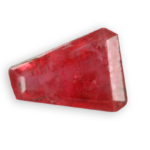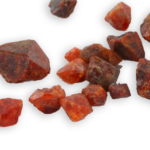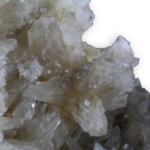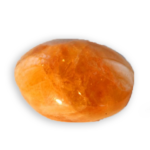
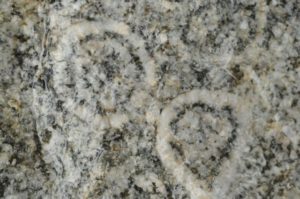
orbicular diorite
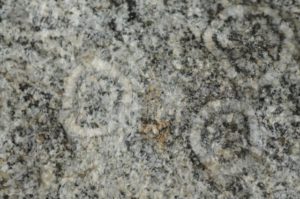
orbicular diorite from Corsica
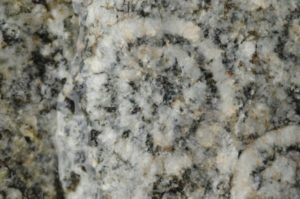
detail of the orbicular diorite from Corsica
Detailed sheet
orbicular diorite
Successively described and analyzed by many specialists since 1851, its a mixture of feldspar, hornblende, biotite (black mica) and quartz.
It is considered an intrusive rock with a texture similar to “granite”, the term “granite” designating a hard stone used in civil engineering. The matrix is coarser than those of hornblende granite, of anorthite and of bytownite cashing veins, specially the pebbles areas (not “orbits”), greenish-blue to blue-gray, with a density of about 2.80.
Some spheroidal clusters, only feldspathic or some mosaics of very fine misguided anorthite debris, of varying sizes, isolated or clustered and unevenly distributed, form some alternating concentric light and dark areas whose genesis is not exactly explained.
The diameter of these pebbles is 2 to 30 centimeters and the number of sheets from the unit to twenty, their spacing being along a geometric progression.

CHEMICAL CHARACTERISTICS

PHYSICAL CHARACTERISTICS
Main color
grey
Other colors
white, blue, black, pink, green, purple
it forms rounded lumps of color
Hardness
0.0 to 0.0
Density
2.80 to 0.00
Cleavage
none
Fracture
granular, uneven

OPTICAL PROPERTIES
Transparency
opaque
Refractive index
0.000 - 0.000
Double refraction
0.000
undetectable, opaque rock
visible double refraction
No
Pleochroism
absent
Number of colors
1
Fluorescence
none

CRYSTALS PROPERTIES
mixture of various constituents

OTHER INFORMATIONS
Astrological sign
Aries, Libra

APPROACHING GEMS
Exploited
sites
This is a “specialty” of Corsica in France …
Nevertheless deposits have been discovered around the world.
use in jewelry
Orbicular diorite can be cabochon cut and is used to manufacture decorative objects: ashtrays, boxes, statuettes …
Daily care
and precautions
slightly fragile rock
Historical
healing properties
Healers consider it to imprison the negative energies, and a large piece placed in a room of a house even to absorb the negative thoughts, but it must be purified frequently as it would act as a sponge that will saturate. Placed on the third eye it would do the same.
On the solar plexus chakra, it would regulate the digestive system. On the heart chakra, it would strengthen the chest capacities. On the Throat chakra, it would alleviate cough and hoarseness.
historical stones
and related legends
The history of orbicular diorite is worthy of a novel: in 1786, de Saussure pointed at Miage glacier in the Mont-Blanc, an orbicular rock of hornblende that J. Pinkerton called miagite in 1811.
In 1809, it was discovered in proximity of Santa Lucia-di-Tallano near Sartene (Corsica), a rock that looks like a panther skin, it was named it corsilite, for a short time indeed, because in 1811, the journal Petrology regarded it as a mere variety of granite. On 21 November 1853 before the Geological Society of France, Mr. Constant Prevost was reading a letter of June 8, received from Corsica, that detailed “the deposit of a remarkable rock ….”
This “corsite” was described as unique in the world … before being found in Finland! Almost a hundred deposits were found around the world (1966).
Venez visitez
notre site web
voillot-joaillier.fr
Lorem ipsum dolor sit amet, consectetur adipiscing elit. Ut elit tellus, luctus nec ullamcorper mattis, pulvinar dapibus leo.Lorem ipsum dolor sit amet, consectetur adipiscing elit. Ut elit tellus, luctus nec ullamcorper mattis, pulvinar dapibus leo consectetur adipiscing elit. Ut elit tellus, luctus nec.

